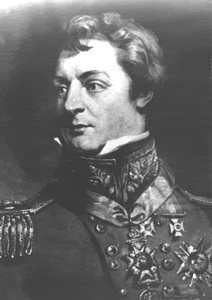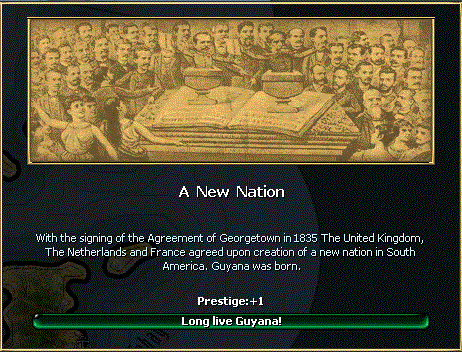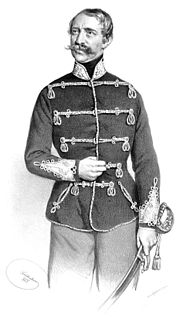Chapter One - History of Guyana
Set like a gem in the crown of South America, nestled on the North-Eastern shoulder, defying the raging Atlantic Ocean, Guyana's many waterways reflect the source of it's name "The Land of Many Waters" Guyana was discovered in 1498 by the Europeans, its history; therefore stretches back a bit more than 500 years. Guyana's past is punctuated by battles fought and won, possessions lost and regained as the Spanish, French, Dutch and British wrangled for centuries to own this land.
Pre-colonial Guyana and first contacts
The first humans to reach Guyana belonged to the group of people that crossed into North America from Asia perhaps maybe as much as 35,000 years ago. These first inhabitants were nomads who slowly spread south into Central America and South America. Although great civilizations later arose in the Americas, the structure of Amerindian society in the Guianas remained relatively simple. At the time of Christopher Columbus's voyages, Guyana's inhabitants were divided into two groups, the Arawak along the coast and the Carib in the interior. One of the legacies of the indigenous peoples was the word Guiana, often used to describe the region encompassing modern Guyana as well as Suriname (former Dutch Guiana) and French Guiana. The word, which means "land of waters", is highly appropriate, considering the area's multitude of rivers and streams.
Historians speculate that the Arawak and Carib originated in the South American hinterland and migrated northward, first to the present-day Guianas and then to the Caribbean islands. The peaceful Arawak, mainly cultivators, hunters, and fishermen, migrated to the Caribbean islands before the Carib and settled throughout the region. The tranquility of Arawak society was disrupted by the arrival of the bellicose Carib from the South American interior. Carib warlike behavior and violent movement north made an impact still discussed today. By the end of the fifteenth century, the Carib had displaced the Arawak throughout the islands of the Lesser Antilles. The Carib settlement of the Lesser Antilles also affected Guyana's future development. The Spanish explorers and settlers who came after Columbus found that the Arawak proved easier to conquer than the Carib, who fought hard to maintain their freedom. This fierce resistance, along with a lack of gold in the Lesser Antilles, contributed to the Spanish emphasis on conquest and settlement of the Greater Antilles and the mainland. Only a weak Spanish effort was made at consolidating Spain's authority in the Lesser Antilles (with the arguable exception of Trinidad) and the Guianas.
Early colonization
Although Columbus sighted the Guyanese coast in 1498, during his third voyage to the Americas, the Dutch were the first Europeans to settle what is now Guyana. The Netherlands had obtained independence from Spain in the late 1500s and by the early 1600s had emerged as a major commercial power, trading with the fledgling English and French colonies in the Lesser Antilles. In 1616 the Dutch established the first European settlement in the area of Guyana, a trading post twenty-five kilometers upstream from the mouth of the Essequibo River. Other settlements followed, usually a few kilometers inland on the larger rivers. The initial purpose of the Dutch settlements was trade with the indigenous people. The Dutch aim soon changed to acquisition of territory as other European powers gained colonies elsewhere in the Caribbean. Although Guyana was claimed by the Spanish, who sent periodic patrols through the region, the Dutch gained control over the region early in the seventeenth century. Dutch sovereignty was officially recognized with the signing of the Treaty of Munster in 1648.
In 1621 the government of the Netherlands gave the newly formed Dutch West India Company complete control over the trading post on the Essequibo. This Dutch commercial concern administered the colony, known as Essequibo, for more than 170 years. The company established a second colony, on the Berbice River southeast of Essequibo, in 1627. Although under the general jurisdiction of this private group, the settlement, named Berbice, was governed separately. Demerara, situated between Essequibo and Berbice, was settled in 1741 and emerged in 1773 as a separate colony under direct control of the Dutch West India Company.
Although the Dutch colonizers initially were motivated by the prospect of trade in the Caribbean, their possessions became significant producers of crops. The growing importance of agriculture was indicated by the export of 15,000 kilograms of tobacco from Essequibo in 1623. But as the agricultural productivity of the Dutch colonies increased, a labor shortage emerged. The indigenous populations were poorly adapted for work on plantations, and many people died from diseases introduced by the Europeans. The Dutch West India Company turned to the importation of African slaves, who rapidly became a key element in the colonial economy. By the 1660s, the slave population numbered about 2,500; the number of indigenous people was estimated at 50,000, most of whom had retreated into the vast hinterland. Although African slaves were considered an essential element of the colonial economy, their working conditions were brutal. The mortality rate was high, and the dismal conditions led to more than half a dozen slave rebellions.
Transition to British rule
Eager to attract more settlers, in 1746 the Dutch authorities opened the area near the Demerara River to British immigrants. British plantation owners in the Lesser Antilles had been plagued by poor soil and erosion, and many were lured to the Dutch colonies by richer soils and the promise of landownership. The influx of British citizens was so great that by 1760 the English constituted a majority of the population of Demerara. By 1786 the internal affairs of this Dutch colony were effectively under British control.
As economic growth accelerated in Demerara and Essequibo, strains began to appear in the relations between the planters and the Dutch West India Company. Administrative reforms during the early 1770s had greatly increased the cost of government. The company periodically sought to raise taxes to cover these expenditures and thereby provoked the resistance of the planters. In 1781 a war broke out between the Netherlands and Britain, which resulted in the British occupation of Berbice, Essequibo, and Demerara. Some months later, France, allied with the Netherlands, seized control of the colonies. The French governed for two years, during which they constructed a new town, Longchamps, at the mouth of the Demerara River. When the Dutch regained power in 1784, they moved their colonial capital to Longchamps, which they renamed Stabroeck. The capital eventually would become known as Georgetown.
The return of Dutch rule reignited the conflict between the planters of Essequibo and Demerara and the Dutch West India Company. Disturbed by plans for an increase in the slave tax and a reduction in their representation on the colony's judicial and policy councils, the colonists petitioned the Dutch government to consider their grievances. In response, a special committee was appointed, which proceeded to draw up a report called the Concept Plan of Redress. This document called for far-reaching constitutional reforms and later became the basis of the British governmental structure. The plan proposed a decision-making body to be known as the Court of Policy. The judiciary was to consist of two courts of justice, one serving Demerara and the other Essequibo. The membership of the Court of Policy and of the courts of justice would consist of company officials and planters who owned more than twenty-five slaves. The Dutch commission that was assigned the responsibility of implementing this new system of government returned to the Netherlands with extremely unfavorable reports concerning the Dutch West India Company's administration. The company's charter therefore was allowed to expire in 1792 and the Concept Plan of Redress was put into effect in Demerara and Essequibo. Renamed the United Colony of Demerara and Essequibo, the area then came under the direct control of the Dutch government. Berbice maintained its status as a separate colony.
The catalyst for formal British takeover was the French Revolution and the resulting Napoleonic Wars. In 1795 the French occupied the Netherlands. The British declared war on France and in 1796 launched an expeditionary force from Barbados to occupy the Dutch colonies. The British takeover was bloodless, and local Dutch administration of the colony was left relatively uninterrupted under the constitution provided by the Concept Plan of Redress.
Both Berbice and the United Colony of Demerara and Essequibo were under British control from 1796 to 1802. By means of the Treaty of Amiens, both were returned to Dutch control. Peace was short-lived, however. War between Britain and France resumed in less than a year, and the United Colony and Berbice were seized once more by British troops. At the London Convention of 1814, both colonies were formally ceded to Britain. In 1831, Berbice and the United Colony of Demerara and Essequibo were unified as British Guiana.
Political, economic, and social life in the 1800s was dominated by a European planter class. Although the smallest group in terms of numbers, members of the plantocracy had links to British commercial interests in London and often enjoyed close ties to the governor, who was appointed by the monarch. The plantocracy also controlled exports and the working conditions of the majority of the population. The next social stratum consisted of a small number of freed slaves, many of mixed African and European heritage, in addition to some Portuguese merchants. At the lowest level of society was the majority, the African slaves who lived and worked in the countryside, where the plantations were located. Unconnected to colonial life, small groups of Amerindians lived in the hinterland.
Colonial life was changed radically by the demise of slavery. Although the international slave trade was abolished in the British Empire in 1807, slavery itself continued.
------
* - Map made by Treppe

















